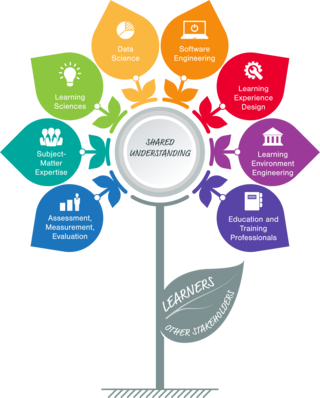Related Research Articles
Educational psychology is the branch of psychology concerned with the scientific study of human learning. The study of learning processes, from both cognitive and behavioral perspectives, allows researchers to understand individual differences in intelligence, cognitive development, affect, motivation, self-regulation, and self-concept, as well as their role in learning. The field of educational psychology relies heavily on quantitative methods, including testing and measurement, to enhance educational activities related to instructional design, classroom management, and assessment, which serve to facilitate learning processes in various educational settings across the lifespan.
Affective computing is the study and development of systems and devices that can recognize, interpret, process, and simulate human affects. It is an interdisciplinary field spanning computer science, psychology, and cognitive science. While some core ideas in the field may be traced as far back as to early philosophical inquiries into emotion, the more modern branch of computer science originated with Rosalind Picard's 1995 paper on affective computing and her book Affective Computing published by MIT Press. One of the motivations for the research is the ability to give machines emotional intelligence, including to simulate empathy. The machine should interpret the emotional state of humans and adapt its behavior to them, giving an appropriate response to those emotions.
A cognitive tutor is a particular kind of intelligent tutoring system that utilizes a cognitive model to provide feedback to students as they are working through problems. This feedback will immediately inform students of the correctness, or incorrectness, of their actions in the tutor interface; however, cognitive tutors also have the ability to provide context-sensitive hints and instruction to guide students towards reasonable next steps.
M-learning, or mobile learning, is a form of distance education where learners use portable devices such as mobile phones to learn anywhere and anytime. The portability that mobile devices provide allows for learning anywhere, hence the term "mobile" in "mobile learning." M-learning devices include computers, MP3 players, mobile phones, and tablets. M-learning can be an important part of informal learning.
This is an index of education articles.
Educational technology is the combined use of computer hardware, software, and educational theory and practice to facilitate learning. When referred to with its abbreviation, "EdTech," it often refers to the industry of companies that create educational technology. In EdTech Inc.: Selling, Automating and Globalizing Higher Education in the Digital Age, Tanner Mirrlees and Shahid Alvi (2019) argue "EdTech is no exception to industry ownership and market rules" and "define the EdTech industries as all the privately owned companies currently involved in the financing, production and distribution of commercial hardware, software, cultural goods, services and platforms for the educational market with the goal of turning a profit. Many of these companies are US-based and rapidly expanding into educational markets across North America, and increasingly growing all over the world."
An intelligent tutoring system (ITS) is a computer system that imitates human tutors and aims to provide immediate and customized instruction or feedback to learners, usually without requiring intervention from a human teacher. ITSs have the common goal of enabling learning in a meaningful and effective manner by using a variety of computing technologies. There are many examples of ITSs being used in both formal education and professional settings in which they have demonstrated their capabilities and limitations. There is a close relationship between intelligent tutoring, cognitive learning theories and design; and there is ongoing research to improve the effectiveness of ITS. An ITS typically aims to replicate the demonstrated benefits of one-to-one, personalized tutoring, in contexts where students would otherwise have access to one-to-many instruction from a single teacher, or no teacher at all. ITSs are often designed with the goal of providing access to high quality education to each and every student.
Kenneth R. Koedinger is a professor of human–computer interaction and psychology at Carnegie Mellon University. He is the founding and current director of the Pittsburgh Science of Learning Center. He is widely known for his role in the development of the Cognitive Tutor software. He is also widely published in cognitive psychology, intelligent tutoring systems, and educational data mining, and his research group has repeatedly won "Best Paper" awards at scientific conferences in those areas, such as the EDM2008 Best Paper, ITS2006 Best Paper, ITS2004 Best Paper, and ITS2000 Best Paper.
Carelessness refers to the lack of awareness during a behaviour that can result in unintended consequences. The consequences way of carelessness are often undesirable and tend to be mistakes. A lack of concern or an indifference for the consequences of the action due to inattention may partake in the origin of carelessness.
E-learning theory describes the cognitive science principles of effective multimedia learning using electronic educational technology.
Reasoning Mind is a non-profit organization that develops computer-based math curricula and works with schools to implement them in classrooms. In addition, Reasoning Mind provides professional development to teachers using the program. The organization works closely with partner schools to help them achieve a successful implementation. Reasoning Mind uses Instruction Modeling and the Baker Rodrigo Ocumpaugh Monitoring Protocol as core components of its research and development process.
Peer assessment, or self-assessment, is a process whereby students or their peers grade assignments or tests based on a teacher's benchmarks. The practice is employed to save teachers time and improve students' understanding of course materials as well as improve their metacognitive skills. Rubrics are often used in conjunction with self- and peer-assessment.
Educational data mining (EDM) is a research field concerned with the application of data mining, machine learning and statistics to information generated from educational settings. At a high level, the field seeks to develop and improve methods for exploring this data, which often has multiple levels of meaningful hierarchy, in order to discover new insights about how people learn in the context of such settings. In doing so, EDM has contributed to theories of learning investigated by researchers in educational psychology and the learning sciences. The field is closely tied to that of learning analytics, and the two have been compared and contrasted.

A pedagogical agent is a concept borrowed from computer science and artificial intelligence and applied to education, usually as part of an intelligent tutoring system (ITS). It is a simulated human-like interface between the learner and the content, in an educational environment. A pedagogical agent is designed to model the type of interactions between a student and another person. Mabanza and de Wet define it as "a character enacted by a computer that interacts with the user in a socially engaging manner". A pedagogical agent can be assigned different roles in the learning environment, such as tutor or co-learner, depending on the desired purpose of the agent. "A tutor agent plays the role of a teacher, while a co-learner agent plays the role of a learning companion".
Vincent Aleven is a professor of human-computer interaction and director of the undergraduate program at Carnegie Mellon University's Human–Computer Interaction Institute.

Kahoot! is a Norwegian online game-based learning platform. It has learning games, also known as "kahoots", which are user-generated multiple-choice quizzes that can be accessed via a web browser or the Kahoot! app.
Emotion recognition is the process of identifying human emotion. People vary widely in their accuracy at recognizing the emotions of others. Use of technology to help people with emotion recognition is a relatively nascent research area. Generally, the technology works best if it uses multiple modalities in context. To date, the most work has been conducted on automating the recognition of facial expressions from video, spoken expressions from audio, written expressions from text, and physiology as measured by wearables.

Ryan S. Baker is professor of education and computer science at the University of Pennsylvania, and also directs the Penn Center for Learning Analytics. He is known for his role in establishing the educational data mining scientific community, for the Baker Rodrigo Ocumpaugh Monitoring Protocol (BROMP), and for establishing the first automated detector of student disengagement. He was awarded the Educational Research Award for 2018 by the Council of Scientific Society Presidents.

Bruce Martin McLaren is an American researcher, scientist and author. He is an Associate Research Professor at Carnegie Mellon University and a former President of the International Artificial Intelligence in Education Society (2017-2019).

Learning Engineering is the systematic application of evidence-based principles and methods from educational technology and the learning sciences to create engaging and effective learning experiences, support the difficulties and challenges of learners as they learn, and come to better understand learners and learning. It emphasizes the use of a human-centered design approach in conjunction with analyses of rich data sets to iteratively develop and improve those designs to address specific learning needs, opportunities, and problems, often with the help of technology. Working with subject-matter and other experts, the Learning Engineer deftly combines knowledge, tools, and techniques from a variety of technical, pedagogical, empirical, and design-based disciplines to create effective and engaging learning experiences and environments and to evaluate the resulting outcomes. While doing so, the Learning Engineer strives to generate processes and theories that afford generalization of best practices, along with new tools and infrastructures that empower others to create their own learning designs based on those best practices.
References
- ↑ Baker, Ryan; Corbett, Albert; Koedinger, Kenneth; Wagner, Angela (2004). "Off-task behavior in the cognitive tutor classroom: when students game the system". Proceedings of the International Conference on Computer-Human Interaction. Association for Computing Machinery. pp. 383–3gf90.
- ↑ Rodrigo, Mercedes (2007). "Affect and Usage Choices in Simulation Problem Solving Environments". Proceedings of the International Conference on Artificial Intelligence in Education. IOS Press. pp. 145–152.
- ↑ Ocumpaugh, Jaclyn; Baker, Ryan; Rodrigo, Mercedes (2012). Baker-Rodrigo Observation Method Protocol (BROMP) 1.0. Training Manual version 1.0 (PDF). EdLab.
- 1 2 Ocumpaugh, Jaclyn; Baker, Ryan; Rodrigo, Mercedes (2015). Baker Rodrigo Ocumpaugh Monitoring Protocol (BROMP) 2.0 Technical and Training Manual (PDF). EdLab.
- 1 2 Hymavathy, Chokanath; Krishnamani, Viola; Sumathi, C.P. (2014). "Analyzing learner engagement to enhance the teaching-learning experience". Proceedings of the International Conference on MOOC, Innovation and Technology in Education (MITE). IEEE. pp. 67–70. doi:10.1109/MITE.2014.7020243.
- ↑ "Program News". Archived from the original on 27 September 2015. Retrieved 15 February 2015.
- ↑ Ocumpaugh, Jaclyn; Baker, Ryan; Rodrigo, Mercedes; Salvi, Aatish; van Velsen, Martin; Aghababyan, Ani; Martin, Taylor (2015). "HART: the human affect recording tool". Proceedings of the 33rd International Conference on the Design of Communication. Association for Computing Machinery.
- ↑ Baker, Ryan; Ocumpaugh, Jaclyn & Andres, Juliana (2020). "BROMP Quantitative Field Observations: A Review" (PDF). In Feldman, Robert (ed.). Learning Science: Theory, Research, and Practice. McGraw-Hill. pp. 127–156.
- ↑ Baker, Ryan (2012). "Towards Sensor-Free Affect Detection in Cognitive Tutor Algebra". Proceedings of the International Conference on Educational Data Mining. International Educational Data Mining Society. pp. 126–133.
- ↑ Mulqueeny, Kevin; Kostyuk, Victor; Baker, Ryan; Ocumpaugh, Jaclyn (2015). "Incorporating Effective e-Learning Principles to Improve Student Engagement in Middle-School Mathematics". International Journal of STEM Education. 2 (15). doi: 10.1186/s40594-015-0028-6 .
- ↑ "About Black Rock Forest Consortium" . Retrieved 17 November 2015.